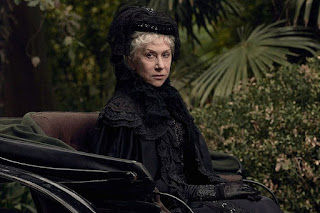Widow who built 500 room mansion for the spirits who haunted her because of her fortune
Helen Mirren stars as the tragic widow who never stopped building in case she died in in new film Winchester.
Sarah Winchester had good reason to believe she had been singled out by dark forces.At just 26, she lost her infant daughter Annie. Fifteen years later her beloved husband William died of tuberculosis. The couple had had no more children and Sarah was understandably heartbroken.
Stricken by inconsolable grief, she turned to a famous psychic in Boston called Adam Coons in the hope he could provide some guidance.
The answer he came up with was extreme, the solution bizarre and the strange tale has been turned into a film starring Helen Mirren as the unfortunate Sarah.
THE CURSED FORTUNE
By any estimate Sarah Winchester was a wealthy woman. Her husband's father Oliver Winchester founded the firearms company which invented the revolutionary repeating weapon called the Henry rifle.Later it produced En fields and Browning automatics for the British army.
The company made Winchester senior a fortune but he would not live to enjoy it, dying in 1880. His son followed a year later leaving wife Sarah a very rich widow with a fortune worth £360million in today's money.
Sales of the weapons brought in a daily income of tens of thousands of pounds.
But it was the source of this vast fortune that the psychic said was at the heart of Sarah's problem. He claimed her family had been cursed by everyone ever killed by a Winchester rifle.
The only answer was to make a home for these troubled spirits and to never stop building because halting the work would result in her death.
BUILDING BEGINS
In 1884, she bought a small farmhouse in San Jose, just south of San Francisco and employed workmen to expand it. They built seven days a week, 24 hours a day.The work was completely unguided by any sort of coherent building plan, and it continued unabated until 1922 when Sarah died.
Whimsical architectural features, rooms and different wings and floors were added haphazardly, resulting in a rambling, bizarre puzzle of secret passageways, stairways and doors that do not go anywhere, and windows with views into other interior rooms.
There was even a room constructed specifically for conducting séances.
At its peak, the house had more than 500 rooms, more than 10,000 windows, and many dozens of fireplaces and stairways.
It soon became a seven-storey mansion with low rising stairs so the sedate widow could move about.
There were 40 bedrooms, two ballrooms (one completed and one unfinished), 47 fireplaces and more than 10,000 panes of glass.
There were 17 chimneys, two basement levels, three lifts and many other luxurious features.
Sarah never skimped on the many adornments that she believed contributed to its architectural beauty.
Stained glass windows were created by the Tiffany Company. Some were designed specifically for her, and others by her, including a "spider web" window that featured her favorite web design and the repetition of the number thirteen.
This window was never installed, but put in the so-called "$25,000 storage room" - so named because its contents were originally appraised at a value of $25,000. The value today is inestimable, but $25,000 would be equivalent to £200,000 today.
A second window was designed by Tiffany himself, so that when sunlight strikes the prismatic crystals a rainbow is cast across the room.
The window was installed in an interior wall in a room with no light exposure, preventing the effect from being seen.
Another window has 13 glass stones in it, staircases have 13 steps, walls and ceilings have 13 panels.
One room has a conical shape which has given it the name Witch’s Cap, and was apparently designed to create a strange echo.
Back during her lifetime it was believed the number only brought misfortune to bad people.
Legend has it Sarah would sleep in a different bedroom each night and the house only had one working toilet to further confuse otherworldly visitors.
And many of the serving staff needed a map to navigate the house.
When Sarah died at 82, all of her possessions (apart from the house) were bequeathed to her niece and personal secretary who took everything she wanted and sold the rest in a private auction.
It supposedly took six trucks working eight hours a day for six weeks to remove all of the furniture from the home.
The house was partially destroyed in an earthquake but what remains is now a tourist attraction and in 2016, it was announced that another room was found—an attic space that contains a pump organ, Victorian couch, dress form, sewing machine and paintings.


.jpeg)
.jpeg)


.jpeg)

.jpeg)
.jpeg)
.jpeg)
